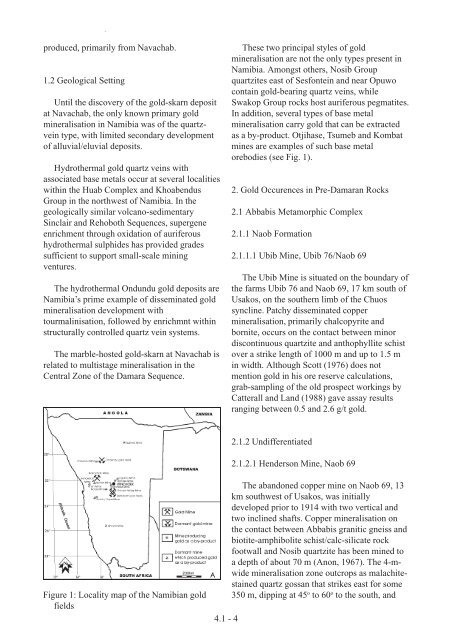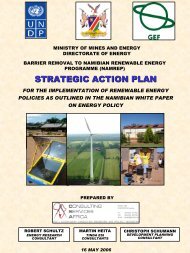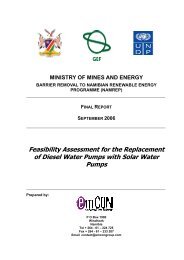Gold Chapter (855 KB) - Ministry of Mines and Energy
Gold Chapter (855 KB) - Ministry of Mines and Energy
Gold Chapter (855 KB) - Ministry of Mines and Energy
You also want an ePaper? Increase the reach of your titles
YUMPU automatically turns print PDFs into web optimized ePapers that Google loves.
Mineral Resources <strong>of</strong> Namibia Precious Metals - <strong>Gold</strong><br />
produced, primarily from Navachab.<br />
1.2 Geological Setting<br />
Until the discovery <strong>of</strong> the gold-skarn deposit<br />
at Navachab, the only known primary gold<br />
mineralisation in Namibia was <strong>of</strong> the quartzvein<br />
type, with limited secondary development<br />
<strong>of</strong> alluvial/eluvial deposits.<br />
Hydrothermal gold quartz veins with<br />
associated base metals occur at several localities<br />
within the Huab Complex <strong>and</strong> Khoabendus<br />
Group in the northwest <strong>of</strong> Namibia. In the<br />
geologically similar volcano-sedimentary<br />
Sinclair <strong>and</strong> Rehoboth Sequences, supergene<br />
enrichment through oxidation <strong>of</strong> auriferous<br />
hydrothermal sulphides has provided grades<br />
sufficient to support small-scale mining<br />
ventures.<br />
The hydrothermal Ondundu gold deposits are<br />
Namibia’s prime example <strong>of</strong> disseminated gold<br />
mineralisation development with<br />
tourmalinisation, followed by enrichmnt within<br />
structurally controlled quartz vein systems.<br />
The marble-hosted gold-skarn at Navachab is<br />
related to multistage mineralisation in the<br />
Central Zone <strong>of</strong> the Damara Sequence.<br />
Figure 1: Locality map <strong>of</strong> the Namibian gold<br />
fields<br />
4.1 - 4<br />
These two principal styles <strong>of</strong> gold<br />
mineralisation are not the only types present in<br />
Namibia. Amongst others, Nosib Group<br />
quartzites east <strong>of</strong> Sesfontein <strong>and</strong> near Opuwo<br />
contain gold-bearing quartz veins, while<br />
Swakop Group rocks host auriferous pegmatites.<br />
In addition, several types <strong>of</strong> base metal<br />
mineralisation carry gold that can be extracted<br />
as a by-product. Otjihase, Tsumeb <strong>and</strong> Kombat<br />
mines are examples <strong>of</strong> such base metal<br />
orebodies (see Fig. 1).<br />
2. <strong>Gold</strong> Occurences in Pre-Damaran Rocks<br />
2.1 Abbabis Metamorphic Complex<br />
2.1.1 Naob Formation<br />
2.1.1.1 Ubib Mine, Ubib 76/Naob 69<br />
The Ubib Mine is situated on the boundary <strong>of</strong><br />
the farms Ubib 76 <strong>and</strong> Naob 69, 17 km south <strong>of</strong><br />
Usakos, on the southern limb <strong>of</strong> the Chuos<br />
syncline. Patchy disseminated copper<br />
mineralisation, primarily chalcopyrite <strong>and</strong><br />
bornite, occurs on the contact between minor<br />
discontinuous quartzite <strong>and</strong> anthophyllite schist<br />
over a strike length <strong>of</strong> 1000 m <strong>and</strong> up to 1.5 m<br />
in width. Although Scott (1976) does not<br />
mention gold in his ore reserve calculations,<br />
grab-sampling <strong>of</strong> the old prospect workings by<br />
Catterall <strong>and</strong> L<strong>and</strong> (1988) gave assay results<br />
ranging between 0.5 <strong>and</strong> 2.6 g/t gold.<br />
2.1.2 Undifferentiated<br />
2.1.2.1 Henderson Mine, Naob 69<br />
The ab<strong>and</strong>oned copper mine on Naob 69, 13<br />
km southwest <strong>of</strong> Usakos, was initially<br />
developed prior to 1914 with two vertical <strong>and</strong><br />
two inclined shafts. Copper mineralisation on<br />
the contact between Abbabis granitic gneiss <strong>and</strong><br />
biotite-amphibolite schist/calc-silicate rock<br />
footwall <strong>and</strong> Nosib quartzite has been mined to<br />
a depth <strong>of</strong> about 70 m (Anon, 1967). The 4-mwide<br />
mineralisation zone outcrops as malachitestained<br />
quartz gossan that strikes east for some<br />
350 m, dipping at 45 o to 60 o to the south, <strong>and</strong>




